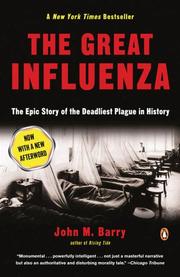Jeff McNeill reviewed The Great Influenza by John M. Barry
Review of 'The Great Influenza' on 'Goodreads'
5 stars
The most important book to read about pandemics. Terrifying.
I've learned so much about the pandemic and the brave men and women who learned and led during this terror. A significant part of the early chapters includes the biographies of such leaders, specifically the medical scientists, and also the development of institutions of medical research including Johns Hopkins. These chapters are a bit dull but thorough and give an idea of the development of germ theory and the insights needed to build vaccines and treatments, and how quickly they got to work (but also how much more quickly the pandemic acted). In so many chapters are shown how decisive actions were taken, but they were a few days too late, which meant millions of deaths.
The early history of how the pandemic swept through military camps in the United States (this is during WWI) is well documented, as is what happened in Philadelphia as the pandemic swept through the city. The overloading of hospitals, the sickness and death of medical workers, the horror of death and the stacking up of bodies everywhere:
"The most terrifying aspect of the epidemic was the piling up of bodies ... bodies stacked up ... stacked up out to be buried ... They couldn't bury them. The bodies backed up more and more, backed up in the houses, were put outside on porches.... people too sick to cook for themselves, too sick to clean themselves, too sick to move the corpse off the bed, lying alive on the same bed with the corpse. The dead lay there for days, while the living lived with them, were horrified by them, and perhaps more horribly, became accustomed to them."
Social distancing, gauze masks, and quarantine were all found to be effective and were soon used throughout the country. Already on a war footing, with mobilizing of troops, the United States and other countries were probably in a better mindset to take action, while at the same time the mass movement of people within the military was an imediate force for spreading the pandemic. If we compare that now with the widespread incompetence of a president and executive unwilling to take action, and who actively undermine the science-led activities needed to contain a pandemic, certainly even with more limited resources and scientific insight, they made the most of what they could do, and were heroic in their actions.
"This was influenza, only influenza" begins Chapter 20, making clear that a majority of cases got better, with 10 to 20 percent mortality in Western countries. In more isolated locations which did not have regular exposure to influenza, there was far higher mortality. "Influenza is a special instance among infections diseases. This virus is transmitted so effectively that it exhausts the supply of susceptible hosts." This means it is highly contagious, and also for "a minority of cases, and not just in a tiny minority, the virus manifested itself in an influenza that did not follow normal patterns, that was unlike any influenza ever reported."
Estimates are that 500m people worldwide were infected by the Spanish Flu, and 50m people died. In the United States it is suggested there were 2-3m severe cases which means between 10-30m people were infected in a population of 100m. As with the current coronavirus, people with influenza can appear healthy yet be contagious, and can be contagious for many days before any symptoms appear. This is why tests of body temperature alone are woefully inadequate at assessing whether someone has the disease, in a location with active in-the-wild infections.
The 1918 Spanish Flu was around in 1917, but it mutated or combined with another virus to form a much more virulent form. In 1917 and early 1918 there was very low death rate, and everyone considered it to be a 3-day flu -- serious but survivable. However, it came back in a different form in a second wave of infections in late 1918. This is something not understood today when people discuss a second wave. It is not only seasonality that would make the current pandemic of a greater threat, but through what is known as "passage" through different hosts (of the same or different species) a virus can become much more virulent (as well as less virulent, depending on the situation). In the end, the Spanish Flu "killed enough to depress the average life expectancy in the United States by more than ten years" and during the course of the epidemic, nearly half of all deaths was "due to the influenza and its complications".
It also killed the young and the strong, and not only the sick and the old. In the US military, one in every sixty-seven men died from influenza and its complications "nearly all of them in a ten-week period beginning in mid-September 1918". The cause of death was not the virus per se, but rather the massive immune response to the virus, which healthy bodies were capable of mounting. Because the virus was so effective at infecting not only the upper respiratory tract but all the way down into the lungs, the immune system followed it and used its strongest weapons, cytokines which are extremely toxic.
"Young adults have the strongest immune system in the population, most capable of mounting a massive immune response. Normally that makes them the healthiest element of the population. Under certain conditions, however, that very strength becomes a weakness."
Acute respiratory distress syndrom (ARDS) is the overarching pathological process which ends in recovery or death, but "there is no way of stopping the process of disintigration in the lung once it begins. The only care is supportive, keeping the victim alive until he or she can recover." This is why intensive care units are so vital. Once ARDS patients enter intensive care, there is a 40-60% mortality. Without intensive care (oxygen, ventilators, etc.) there is a near 100% mortality.
Coronaviruses are not influenza, but they do cause 15-30% of all colds, and like influenza attack the same epithelial cells leading into the lungs, and follow the same pathology. Coronaviruses "replicate much more slowly than influenza, and therefore death from ARDS can come several weeks after the first symptoms." ARDS is not the main cause of death of the Spanish Flu, or the majority, but explains those who died very quickly after infection. Most people died due to bacterial pneumonias.
"Bacterial pneumonias developed a week, two weeks, three weeks after someone came down with influenza, including even a seemingly mild case of influenza. Often influenza victims seemed to recover, even returned to work, then suddenly collapsed with bacterial pneumonia."
Even with modern antibiotics, there is still a mortality rate of 7% for bacterial pneumonia following influenza. However, "35% of pneumococcal infects are resistant to the antibiotic of choice" and when staphylococcus aureus is the cause, the death rate, even today, "rises to as high as 42%".
There was an equivalent to Trump in the age of the Spanish Flu, and that was Tammany Hall's John Hylan elected as Mayor of New York in 1918. He gutted the Department of Health of professionals, turning their positions into patronage. "Hylan demanded the firing of division chiefs and the removal of highly respected physicians on the advisory board." He appointed Royal Copeland as the new health commissioner. A dean of a homeopathic medical school, Copeland was not even an M.D. "The best municipal public health department in the world was now run by a man with no belief in modern scientific medicine and whose ambitionis were not in public health but in politics." Tammany repaid Copeland's loyalty by supporting his successful candidacy to the United States Senate.
Reviewing the kinds of pronouncements that Copeland made when influenza deaths in NYC began is like reading Trump's tweets from February, 2020. The only thing that prevented Copeland from having a negative effect on those working on the cure in NYC was immense political pressure to not further politicize and destabilize the actual work of medical researchers. We can only hope that this is the case within the CDC. (Note: five months after publishing this review we now know that our worst fears have been realized with Trump corrupting the CDC.)
Rupert Blue, the head of the US Public Health Services was weak and in fact blocked requests for resources, harming the public health effort. President Woodrow Wilson never talked about the Spanish Flu. He would later contract it in Paris, in 1919. There is strong evidence that the mental discombobulation which accompanied the Spanish Flu in Wilson led directly to abandoning his principles in trying to negotiate "a lasting peace" namely "a peace without victory". It may be that the fantastically disastrous peace treaty Wilson agreed to, and one of the major causes of WWII in Europe, is a direct result of the Spanish Flu.
Nothing could have prevented the "sweep of influenza through either the United States or the rest of the world". However, "ruthless interventions and quarantines might have interrupted its progress and created occasional firebreaks". And this would be important because the virus was becoming weaker over time. "Reversion to the mean" took place in the sense that the highly virulent strain of the virus in late 1918 was an outlier mutation, as most viruses are less virulent. Mutation occured and less virulence was the result, as was most likely to be the case.
The third wave in November/December 1918 was still a horrendous strain by any account with millions suffering, though less virulent. The disease was still present throughout the world throughout 1919. The fourth wave of the Spanish Flu in epidemic form occurred in the United States early 1920. Indeed, there were sporadic infections in different cities in the United States even as late as 1922. These were not all declared an influenza epidemic, but the same cautions and treatments were realized. While initial contact with a particular strain did grant some immunity, it was not uncommon to be reinfected two or three times with each subsequent wave of mutated virus.
The impact on the community beyond raw numbers of dead is hard to imagine. "Even before the epidemic ended, New York City Health Commissioner Royal Copeland estimated that twenty-one thousand children in the city had been made orphans by the epidemic. He had no estimate of children who lost only one parent."

